by Allison Leo | Apr 29, 2022
Benefits of being recognized

Ways to feel special without food! Youth receiving rosette for a job well done!
One of the most important aspects of working with youth is the relationships that we build with them. Recognition is a basic human need, and in 4-H, recognition of youth members for their knowledge gained and mastery of skills is an important part of our positive youth development program. Using incentives and prizes during a 4-H program can be an effective way to create a sense of belonging. While working with youth, it is important to acknowledge their achievements and hard work throughout the club year.
Using Food as a Reward
Candy and sweets are often used to reward good behavior or accomplishments because kids like them and they are inexpensive. It is tempting to lean towards sweets and candy when selecting rewards and prizes for youth, but when food is given as a reward, children start to connect it to good or bad, and not fuel for the body. Rewarding youth with sweets can contradict the teaching and modeling of behaviors that promote healthy life skills in 4-H. Often, these foods have little or no nutritional value.
Non-food Rewards
Non-food rewards are a great option for acknowledging youth at 4-H club meetings, in school, and while at home. By using non-food rewards to acknowledge behavior, this promotes a healthy environment and helps children develop a healthy relationship with food. Recognizing youth with words of appreciation are better motivators than rewards of food. Telling a child, “I am so impressed with how hard you worked on your project,” is a healthy alternative to giving them candy for their success.
Creating an Inclusive Environment
Non-food rewards also create an inclusive environment for those we have food allergies and cannot partake in many food rewards. The Centers for Disease Control and Prevention’s (CDC) “Voluntary Guidelines for Managing Food Allergies in Schools and Early Care and Education Programs” recommends the “use of non-food incentives for prizes, gifts, and awards.” While a shift to non-food incentives may require slight changes to traditions, there are many potential benefits. Below is a list of free and low-cost reward options to use with kids.
Free
- Certificate
- Lead a game or activity
- Help teach lesson
- Trip to the park
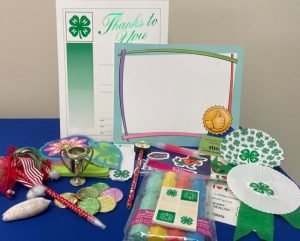
Examples of non food reward items.
- Special privilege at home or club meeting
- Book exchange
Low-cost rewards
- Stickers
- Stress balls
- Notepads
- receive a plant, seeds and a pot for growing
- Pencils
- Art supplies
- Coloring book g
- Glitter
- Bookmarks
- Cupcake Wrapper Rosette
- Small toys
- Stencils
Group rewards
- Bowling party
- Field day
- Movie day
- Trip to a community park
- Canoe or kayak trip
by Allison Leo | Jan 6, 2022
The holidays are a joyous and wonderful time of year, but can also be very busy time, and at times, overwhelming. Now that we are back it is time to Children shift into the organized, orderly school day from that unstructured holiday break schedule. As a result, it is inevitable that children may feel some degree of stress from these transitions. Children and teens are still learning to regulate emotions, making them more susceptible to change’s resulting in stress.
Mindfulness is the act of creating awareness of your surroundings, emotions, and physical self in the present moment. It helps you connect to the world around you, while providing cognitive, social, and emotional benefits. Practicing mindfulness is not just for adults. Children can reap a multitude of benefits from learning and practicing mindfulness. Mindfulness equips children with the ability to adjust and deal with conflict encountered in their daily lives. It can also help children foster an optimistic outlook in life, react to stress in a healthy way, and develop a positive self-concept.
The practice of mindfulness is foreign to some adults, making it tricky to teach and model for young children. The best thing to do is keep the message simple and focus on modeling the behaviors. Being taught by an adult that models mindful behaviors daily will assist youth in mastering the techniques. Below are a few mindfulness activities you can do at home as a family or in a group learning environment, such as a 4-H club meeting.
Enjoy Nature
Going on a mindful walk is a simple way to help clear your mind and restore your focus. Taking a nature walk around your neighborhood or park is an easy way to exercise your mindfulness skills and enjoy nature. You can make it exciting by telling them you are going on a “mindfulness safari” and the goal is to see how many different birds, insects, and animals you can find on your journey. Below are some tips for going on a mindful walk:
- Start at a slow pace and gradually increase as the walk continues.
- Pay attention to the feeling in your legs and feet as you take each step. Then, notice how your arms and torso feel as you walk.
- Notice any smells around you.
- Listen to the variety of sounds around you. Notice if the sounds are close or far away.
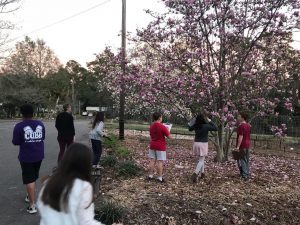
Talking a walk in nature is a simple way to practice mindfulness Photo by Allison Leo
Meditate
Contrary to what you may think, you do not have to sit silently on the ground with your eyes closed to mediate. You can meditate while you are walking, eating, or doing household chores. The goal of meditation is to slow down and be in the moment. Guided meditation led by a family member are a way to relax and help reduce stress. Below is guided meditation titled “Relationship Fingers” from the University of Minnesota Extension.
Relationship Fingers – Start by holding out your hand with your thumb pointed towards yourself. Take a breath. For each finger we are going to be focusing on a relationship we have with someone. There is no ‘right’ person so don’t worry about who you choose.
- Start by holding your pinky finger and think of someone who is far away from you. Take a breath for them. Really look at that relationship. What do you notice?
- Next focus or touch your ring finger. Think of someone who is leaning on you right now or who may be more vulnerable in this moment. Take a breath for them. Really look at that relationship. What do you notice?
- Hold or focus on your middle finger and think of a leader in your life. Take a breath for them. Really look at that relationship. What do you notice?
- Focus on your pointer finger and think of someone who is close to you. Take a breath for them. Really look at that relationship. What do you notice?
- Last, hold or focus on your thumb. Consider the relationship you have with yourself. Take a good look. What do you notice? What are you committed to? Take one last breath and shake it out.
Gratitude
When we feel and express gratitude to people in our lives, it creates loving connections, builds trust, and makes us feel joyful. Gratitude can be shown by giving someone a hug or telling them how much you appreciate them. Gratitude journals can easily be made at home or you can print off a pre-made template. This version is simple and is a great start for kids: https://researchparent.com/gratitude-journal-for-kids/.
- What’s the best book you’ve ever read? What did you like best about the characters?
- Name one thing that makes you smile every time you hear or see it. Why?
- Describe one thing that made you feel cozy today.
- Who is the one friend you can always rely on?
- What are five things you are looking forward to next year?
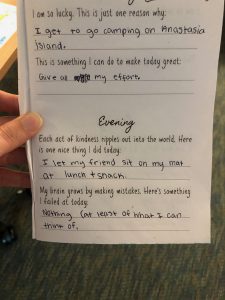
Gratitude Journals are a simple mindfulness activity kids can complete every day
Walker, K., Sharpe, K., Anderson, M., Caines, T., Johnson, C., Kennedy, D., Nguyen, K., Odendahl, S., & Santl, K. (2021). Social Emotional Wellbeing: A Guide to Support Youth Thriving. St. Paul: Regents of the University of Minnesota.
by Allison Leo | Nov 29, 2021
4-H Day at the North Florida Fair celebrated a triumphant return on Saturday November 13. This annual event in Tallahassee took a hiatus in 2020 due to the pandemic but returned in full force this past Saturday. 4-H Day at the Fair is an event that connects 4-H members and their families with each other from across North Florida. The fair was filled with a sea of green as eager 4-H members joined together to compete in 4-H contests, enjoy fair rides, and sample delicious fair food. The North Florida Fair provides 4-H members and volunteers with special deals on rides for the day. 4-H Member Arvaneh G. shared that her favorite part was “all the rides, especially the Himalaya, and the bounce houses”.
Before the rides and fair are open, 4-H Day Starts in the early morning as members compete in a variety of contests. This year, those contests were the STEM Challenge, Consumer Choices, Agriculture Judging, Horticulture Identification, and Wildlife Ecology. Members put their life skills developed through 4-H to work by displaying critical thinking, teamwork, and problem solving during the contests. A total of 116 youth competed in the contests during 4-H Day at the North Florida Fair this year. Participants had the option to compete as individuals or on a team in each contest. Senior 4-H Member Sophia L. shared “it was really great to see the Wildlife Ecology Contest return, we had such a great turn out with a lot of variety in ages”. Sophia expressed how she was excited for the contest to be back, adding “there is something about that friendly competition atmosphere this is really motivating, seeing so many people that are all passionate about similar things”.
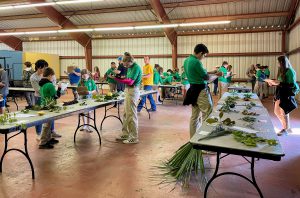
4-H members participating in the Horticulture ID Contest
STEM Contest
The topic of the STEM Challenge Contest this year involved building a roller coaster using the engineer design process. All youth competing in this contest were placed on a team based on their age division. A limited amount of materials were provided and the teams worked together to create a roller coaster that would carry a marble from the top of the coaster to the bottom with at least two loops and one curve. The teams were judged on creativity, communication, and teamwork. The final designs were put on display in the 4-H Building for the remainder of the fair.
Consumer Choices
The Consumer Choices Contest measured the ability of youth to be smart shoppers. The item categories this year were cell phone plans, ground transportation selection, wireless portable speakers, and smoothies. 4-H members had the opportunity to compete in this contest as an individual or on a team. Each individual or team was provided with a “situation card”. Based on the criteria provided in the card, members were asked to review four different choices of each item and rank them from best to worst based on the criteria. After they were finished ranking, they would have to justify their selection through an “oral reasoning” section.
Agriculture Judging
During the Agriculture Judging Contest, individuals and teams were tested on their knowledge of beef, poultry, hay, corn, soybean, and oats. Youth competed both as individuals and on teams with their age division. Agriculture judging consists of analyzing a product (i.e. cattle, soybeans) and measuring it against a standard. Members were asked to analyze four different choices of each item and rank them from best to worst based on the standard.
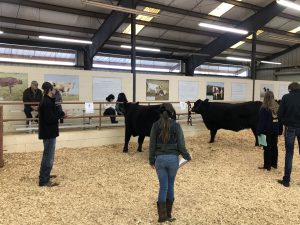
4-H members competing in the Agriculture Judging Contest
Horticulture Identification
The Horticulture Identification Contest tested the ability of members to identify over 60 horticulture specimens. The items were divided into four separate categories. Those categories were ornamentals, fruits & vegetables, flowers, and foliage. The specimens were laid out on tables, each bearing a number that corresponds to a scoresheet, that listed over 100 plant names. This contest replicates the state 4-H Horticulture Contest held each year in June.

Plant specimens in the Horticulture ID Contest
Wildlife Ecology Contest
During the Wildlife Ecology Contest, members were tested on their knowledge of Florida trees, mammals, birds, reptiles, and amphibians. They identified the various items through pictures, physical specimens, and audio sounds. 4-H Member Joycelyn G. joined 4-H this past year and had the opportunity to participate in two contests this year. When asked what her favorite thing about 4-H Day at the Fair was, she answered “I loved the rides and I loved the competition. Thank you very much for having a special spot for me. I really loved the fair. It was the best day ever!”
4-H Exhibits & Club Booth Building
In addition to contests, members had the opportunity to view exhibits and club booths in the 4-H Building at the fair. 4-H members from across the panhandle submit exhibits that express what they have learned through their 4-H experience. Premiums and special merit awards are issued to members whose exhibits demonstrate outstanding efforts and quality in each class. Club booths are constructed by club members and volunteers. The club booths showcase the various 4-H clubs in North Florida.

Leon County 4-H Insect Club created their booth to highlight the importance of pollinators
by Allison Leo | Dec 30, 2020
 4-H clubs and individual members of all ages are eligible to participate in a Community Pride Project. This project is a great way to directly impact your community through a special service learning project of your choice. Service learning is an experiential learning activity and you can read more about what service learning is here or here.
4-H clubs and individual members of all ages are eligible to participate in a Community Pride Project. This project is a great way to directly impact your community through a special service learning project of your choice. Service learning is an experiential learning activity and you can read more about what service learning is here or here.
Community Pride is a service learning program. The objectives of the Community Pride Program are:
- Youth learn about their community and the impact the community has on their lives.
- Youth understand how to relate to their community as individuals and through group cooperation so they can effectively work in community activities, programs, and organizations.
- Youth develop skills and knowledge in community leadership.
- Youth gain experience carrying out community projects to improve their environment.
- Youth develop an interest in and love for their community.
How Does Community Pride Work?
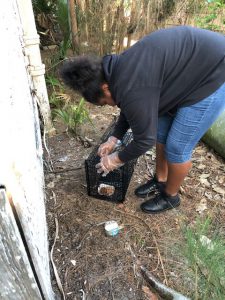
4-H member in Martin County sets up a trap for feral cats as part of the Community Pride Project Photo by: Natalie Parkell
During the project a community issue is identified, a service project is selected, a plan is implemented by the group, and reflection and reporting take place.
What types of projects can you complete through the Community Pride Grant?
That is up to you! The best thing about the project is that you get to select your service learning project based on you community’s need. There are five main steps to the Community Pride Project and those are listed in detail below. Martin County 4-H members received a Community Pride Grant to help combat feral cats in their neighborhood and you can read more about it here. Broward County 4-H members have completed a variety of projects through this program and you can see the variety of projects here. If you would like to receive a Community Pride Grant to complete a service project of your choice, follow the steps below and contact your county 4-H Agent for assistance.
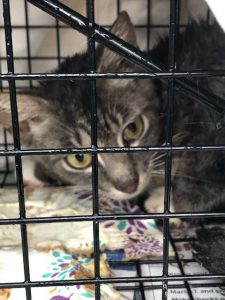
One of the cats that was captured, neutered, and released as part of Martin County 4-H’s Community Pride Project combating feral cats. Photo by: Natalie Parkell
Step 1: Community Needs Assessment
A Needs Assessment might sound intimidating and complicated, but it is a very simple step. Think of a needs assessment as a brainstorming session with the club members. They will share their input from their personal experiences in the community to figure out what project should be selected. It is important for this part to be youth-led because you want to select a project that has a community need and an interest from the youth. During the brainstorming session you will also come up with potential solutions to the problem.
Step 2: Creating a Project Plan
The next step is to create a project plan based on the ideas that were generated during the brainstorming session. Youth will select a solution that they can work towards and this solution will be the project. It is important to consider what steps will need to be completed to make the solution a reality (i.e. supply needs, work days, locating community partners, and more).
Step 3: Submit a Project Proposal
Your next step is to submit a proposal. All 4-H groups (or individual members) who would like to participate in this program must submit a proposal for funding of their Community Pride Project. Proposals accepted from the county must be emailed to 4hcontests@ifas.ufl.edu at the State 4-H Headquarters by the January 11, 2021 deadline date to be considered for the current 4-H years funding. Groups that are awarded funding will be notified via email in February with further instructions on your n
Step 4: Implement your Project
Now for the fun part! This is where you get to put your project plan into action and complete your community project. You will create your own timeline and schedule for the project and it will need to be completed between February through May 2021.
Step 5: Evaluate and Report
After your project is complete, it is time for you to reflect on all your hard work. During this time you will also evaluate the project and submit an official report to the state office by June 1, 2021. The state 4-H Office will conduct judging of all the completed projects during the first week of June. Participants in the Top Five Projects will be invited to a recognition breakfast!
2021 Community Pride Grant Important Dates:
- January 11th, 2021 – Project Proposals Due
- February 2021 – Grant Monies Disbursed
- February to May 2021 – Project Implementation
- June 1st, 2021 – Project Reports Due
Looking for COVID-19 “friendly” Service Project Ideas? Check out this earlier post for suggestions!
by Allison Leo | Oct 30, 2020

Volunteers are a vital part of the Florida 4-H program, and we want to provide our volunteers with the tools needed to be a successful volunteer with your county 4-H program. 4-H Agents in the Northwest District developed a Volunteer Resource Site this year to assist volunteers in their roles. A large part of volunteer success comes from training and preparation, as well as, having access to relevant resources and materials to assist you in your role. The Volunteer Resource Site contains valuable information to prepare, train, and provide support in your role. There are three main sections to the site and you can explore what you will find in each section below. A virtual tour of the site is also available and can be accessed by clicking here.
Apply
Not a volunteer, but interested in how to become one? This section is where you want to start! There is a short video available on how to become a 4-H volunteer along with more detailed step-by-step instructions. You will also find a link to five volunteer orientation videos provided by Florida 4-H. After making contact with your county 4-H Agent to learn what volunteer roles are available in your area, come back to the volunteer site for a direct link to create your volunteer profile in 4-H Online.
Serve
Florida 4-H offers a variety of ways you can volunteer with the program. Under this section of the site you will find a short video discussing the potential volunteer roles. The Serve page also contains direct links to position descriptions of each role for you to further explore each volunteer opportunity. Each position description lists the purpose of the role, your duties and responsibilities, basic qualifications you will need, the resources we will provide you, benefits of volunteering, and the time commitment. The different types of volunteer roles can vary by county and it is recommended to contact your county 4-H agent to learn about the role opportunities in your community.
Learn
This section contains critical resources on specific topics related to your role as a volunteer. We understand that volunteers have busy schedules, therefore, each training item has the completion time listed with it. This allows 4-H volunteers to plan their trainings based on their own schedules. You will find resources on 4-H club management, events, risk management & safety, club meetings, and more in this section.
The Northwest District Virtual Volunteer Leadership Academy training and resources can also be found in this section. You can review the training schedule for the Volunteer Leadership Academy, register for trainings, and watch previously recorded webinars. The Virtual Volunteer Leadership Academy is offered to volunteers and those interested in becoming a volunteer. This series provides monthly webinars to learn new information and skills that will positively impact 4-H youth.
It also allows you to network with other volunteers in the NW Extension District and participants have the potential to earn a social media digital badge!














